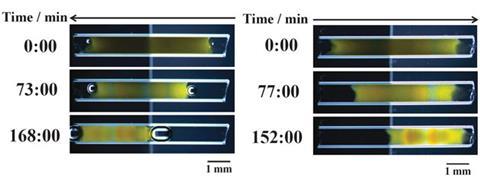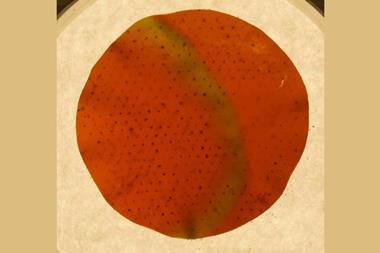Gel reacts to changes in light intensity by moving in different directions thanks to the Belousov–Zhabotinsky reaction
A gel that can move backwards and forwards in a tube in response to changes in light intensity has been developed by an international team of chemists. As it can change its direction of travel, the gel could one day be used as a material to allow tiny intelligent robots to approach more favourable environments or flee advere stimuli.
The gel’s ability to move is thanks to the Belousov–Zhabotinsky (BZ) reaction. BZ reactions are known for their unusual oscillatory properties caused by the non-equilibrium thermodynamics of the reaction. By including the BZ reaction in specific gels, it is possible to obtain soft materials which can show repeated swelling and shrinking on a scale that can even push objects through a tube.
When one end of a BZ gel is made to oscillate faster than the other, the difference in frequency moves the gel in the direction of the faster oscillation. Building on this, a team, led by Irving Epstein at Brandeis University in the US and Qingyu Gao at the China University of Mining and Technology used a photosensitive catalyst for the BZ reaction to make the reaction light sensitive. Fully expecting the gel to move away from the light, the team was quite surprised when they were also able to make the gel move towards the light simply by tweaking the light’s intensity.

Epstein explains this is due to an ‘unexpected maximum in frequency’ where the oscillation frequency reaches a maximum at a particular intensity, that he calls Imax. When illuminated so that both ends are above that point, the darker end will have a higher frequency and the gel moves away from the light. By illuminating the gel so that both ends are below the maximum frequency, the brighter end will then have the higher frequency and the gel moves towards the light. Alternatively, Epstein says, ‘you could also have one end at an intensity above Imax and the other end below it and the direction of motion would depend on which frequency was higher, and you could make the gel to move towards or away from the light simply by changing the intensity at one end.’
Annette Taylor, an expert in chemical oscillators at the University of Leeds in the UK, described the research as ‘a fascinating piece of work that demonstrates how phototaxis [light responsive movement] can be achieved in a synthetic soft matter system.’
The team are now looking at a wide range of approaches to expand this concept, hoping to create complete devices and robots that can respond to different patterns of illumination as well as other stimuli.







No comments yet